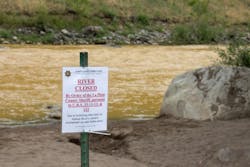EPA to build temporary treatment plant for Gold King Mine wastewater
WASHINGTON — Sept. 23, 2015 — The U.S. Environmental Protection Agency (EPA) will set up a temporary treatment plant to continue treating contaminated water discharged from the Gold King Mine over the winter, according to a press release.
Three million gallons of wastewater was spilled from the mine in southwestern Colorado last month, affecting rivers in three states. The incident was triggered by EPA contractors working at the defunct mine.
Approximately 550 gallons per minute (gpm) of water continue to flow from the mine, including discharges related to ongoing work to stabilize conditions.
According to the EPA, the portable treatment system is necessary because it will be unsafe to operate the settling ponds currently in use when winter temperatures fall below zero.
The new treatment system is planned to be in place by mid-October. Designed to handle up to 1,200 gpm, it will neutralize the mine discharge and remove solids and metals.
EPA spokeswoman Christie St. Clair, quoted by the Orange County Register, said that the agency will decide whether to set up a longer-term treatment plant after conducting a detailed evaluation of other leaking mines in the Upper Animas River watershed.
Colorado U.S. Senators Michael Bennet and Cory Gardner are among those calling for a longer-term solution to the problem. In a letter to EPA Administrator Gina McCarthy this week, they argued that a permanent treatment plant is needed to deal with the mine waste that seeps into the Upper Animas River watershed.
The letter explained: “Legacy mine pollution is a serious, long-standing problem across the West. In the Upper Animas basin alone, four large mines discharge approximately 330 million gallons of acid mine drainage into Cement Creek each year.
“We recognize that the EPA was attempting to address these issues when they triggered the blowout. However, as communities in southwest Colorado look to move forward in the wake of this disaster, they need reassurance that the party responsible for the blowout now has a long-term plan to restore the watershed.”
